The role of microbial communities in maintaining post-harvest sugar beet storability
IF 6.4
1区 农林科学
Q1 AGRONOMY
引用次数: 0
Abstract
Sugar beet is an important crop for sugar production in Europe; however, the loss of sucrose during long storage periods poses a major challenge. Environmental factors coupled with the genetic makeup of the sugar beet influence its storability, with some genotypes showing greater resilience and maintaining high sugar content during storage. The pathogenic part of the plant-associated microbiome is considered one of the main causative agents. However, the same microbiome can also harbor beneficial microbes with potential biocontrol activities that positively affect storability. Despite extensive studies on pre-harvest microbiota, post-harvest microbial community dynamics and their impact on sugar beet quality remain largely unexplored. To uncover the underlying dynamics of microbial patterns associated with different storage capacities, we used 16S rRNA and ITS amplicon sequencing to analyze the bacterial and fungal communities, respectively. Four sugar beet varieties that exhibited disparate storability responses following a 12-week storage trial were investigated. This study identified temporal microbial differences and microbial markers associated with sugar beet storability. Specifically, the fungal class Saccharomycetes, along with the agonistic bacterial genus Gluconobacter, was correlated with reduced storage capacity. In contrast, good storage capacity was characterized by greater microbial diversity, including the fungal indicator taxon Plectosphaerella and the correlating Actinobacteria species. These biomarkers have the potential to be used to identify sugar beet varieties with good storability and to improve the storability of agricultural products.
求助全文
约1分钟内获得全文
求助全文
来源期刊

Postharvest Biology and Technology
农林科学-农艺学
CiteScore
12.00
自引率
11.40%
发文量
309
审稿时长
38 days
期刊介绍:
The journal is devoted exclusively to the publication of original papers, review articles and frontiers articles on biological and technological postharvest research. This includes the areas of postharvest storage, treatments and underpinning mechanisms, quality evaluation, packaging, handling and distribution of fresh horticultural crops including fruit, vegetables, flowers and nuts, but excluding grains, seeds and forages.
Papers reporting novel insights from fundamental and interdisciplinary research will be particularly encouraged. These disciplines include systems biology, bioinformatics, entomology, plant physiology, plant pathology, (bio)chemistry, engineering, modelling, and technologies for nondestructive testing.
Manuscripts on fresh food crops that will be further processed after postharvest storage, or on food processes beyond refrigeration, packaging and minimal processing will not be considered.
 求助内容:
求助内容: 应助结果提醒方式:
应助结果提醒方式:


